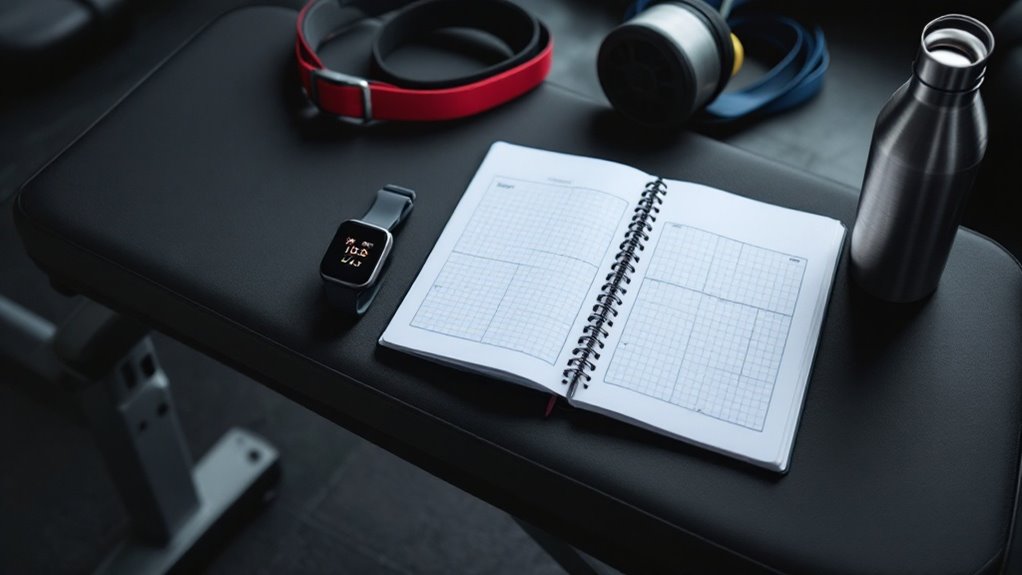Workout Template

A workout template provides essential structure for fitness success through systematic organization of exercises, sets, and rest periods. It incorporates proper warm-ups, progressive overload principles, and strategic recovery times while balancing compound and isolation movements. Effective templates track performance metrics, allow for periodization, and maintain workout consistency through detailed documentation. The template evolves with fitness progression, adapting to changing goals and performance levels. A deeper understanding of template design reveals maximum training potential.
Key Takeaways
- A workout template should include a proper warm-up, main exercises, rest periods, and cool-down sequence for each training session.
- Track exercises, sets, reps, and weights using a consistent format to monitor progress and ensure steady advancement.
- Structure your template with both compound movements and isolation exercises to target multiple muscle groups effectively.
- Include specific workout days and times in your template, treating them as non-negotiable appointments for consistency.
- Incorporate progressive overload principles by gradually increasing weights, sets, or reps to stimulate continuous muscle growth.
Essential Components of an Effective Workout Template

When designing a thorough workout template, several fundamental components must work in harmony to create an effective fitness program.
These essential elements include a proper warm-up sequence, progressive overload planning, strategic rest periods, and exercise variation.
The template should incorporate both compound and isolation movements, structured in a way that optimizes energy systems and prevents overtraining.
Strategic workout design blends compound and isolation exercises to maximize energy efficiency while safeguarding against exercise fatigue.
Tracking mechanisms for recording weights, sets, and reps are vital for measuring progress.
Moreover, the template must account for scheduled deload weeks and recovery protocols.
A well-designed template also integrates mobility work, cardiorespiratory conditioning, and flexibility training to guarantee balanced development.
Incorporating high-intensity interval training with resistance exercises can maximize efficiency by simultaneously improving cardiovascular fitness and muscle strength.
Designing Your Custom Exercise Schedule

Creating a customized exercise schedule begins with understanding personal fitness goals, lifestyle constraints, and available time commitments. The process requires careful consideration of workout frequency, exercise selection, and recovery periods.
A well-designed schedule balances cardio and strength training while accounting for proper rest days. Individuals should map out specific days and times for workouts, treating them as non-negotiable appointments. This structure creates accountability and builds consistency.
The schedule should remain flexible enough to accommodate unexpected changes while maintaining progress toward fitness objectives. Regular evaluation and adjustments guarantee the template evolves with increasing strength and endurance levels. Detailed exercise instructions help users perform each movement correctly while following their personalized fitness routines.
Tracking Progress and Making Adjustments

Monitoring progress serves as the cornerstone of any successful fitness journey. Regular tracking enables individuals to make data-driven adjustments, identify plateaus, and celebrate milestones.
By maintaining detailed records of workouts, measurements, and performance metrics, exercisers can optimize their training protocols for maximum results.
A printable fitness planner provides a convenient offline solution for maintaining consistent workout records without relying on electronic devices.
- Track key metrics: body measurements, weight, strength gains, endurance levels, and progress photos
- Document workout details: exercises performed, sets, reps, weights used, and rest periods
- Review and adjust: analyze trends monthly, modify intensity levels, and update goals based on performance data
Tips for Long-Term Template Success

Success with a workout template demands consistent dedication and strategic implementation beyond the initial setup phase.
Regular template audits guarantee continued effectiveness, while periodization prevents plateaus and maintains progress momentum.
Strategic reviews and cycled training approaches ensure your fitness template stays effective and your progress stays strong.
To optimize long-term success, users should schedule monthly template reviews, document performance metrics consistently, and adjust intensity levels based on recovery patterns.
Small, incremental progressions guard against burnout while maintaining forward momentum.
Creating accountability through training partners or online communities reinforces commitment.
Furthermore, incorporating deload weeks and alternating intensity cycles helps prevent mental fatigue and physical stagnation, guaranteeing the template remains sustainable and motivating throughout the fitness journey.
Following progressive overload principles ensures continuous adaptation and improvement while maintaining proper form and technique.
Frequently Asked Questions
What Should I Do if I Miss a Workout Day?
Missing a workout isn't the end of the world. Simply continue with the next scheduled session without trying to make up the missed one.
Doubling up workouts can lead to overtraining and increased injury risk. Instead, analyze what caused the miss – scheduling conflicts, fatigue, or lack of motivation – and adjust accordingly.
Use it as a learning opportunity to strengthen future workout adherence and consistency.
How Long Should I Stick With the Same Workout Template?
Like a tree growing strong roots, a workout routine needs time to establish its foundation.
One should maintain the same workout template for 8-12 weeks to properly assess progress and allow adaptations. This timeframe lets the body master movements, build strength progressively, and show measurable results.
After this period, evaluate performance metrics and adjust the template to prevent plateaus and maintain continuous growth.
Is It Okay to Exercise Twice in One Day?
Training twice per day can be effective when programmed correctly. This approach, known as "two-a-days," requires adequate rest between sessions and proper nutrition.
The key is separating workouts by at least 6 hours and focusing on different muscle groups or training styles. However, beginners should master single daily sessions before advancing to twice-daily training to prevent overtraining and guarantee proper recovery.
Should I Change My Template During Illness or Injury?
During illness or injury, modifying one's exercise routine is essential for proper recovery.
The body needs adequate time to heal, and continuing with regular intensity could worsen the condition. Depending on the severity, complete rest may be necessary, or activities can be adjusted to avoid affected areas.
Once healing begins, gradually reintroduce exercises while monitoring symptoms and following medical guidance.
Can I Share My Workout Template With Friends of Different Fitness Levels?
Sharing workout templates with friends at different fitness levels can be effective with proper modifications.
The core structure remains the same, but intensity, volume, and exercise variations should be adjusted to match individual capabilities.
Like a blueprint that can be scaled up or down, the template serves as a foundation while allowing customization for beginners, intermediates, or advanced athletes to achieve ideal results.
Final Thoughts
A well-designed workout template serves as the compass in one's fitness odyssey, much like ancient mariners used sextants to steer treacherous waters. Through careful planning, consistent tracking, and strategic adjustments, individuals can forge their path to physical excellence. When properly executed and maintained, these living documents evolve alongside one's fitness journey, ensuring continued progress and sustainable results for years to come.


